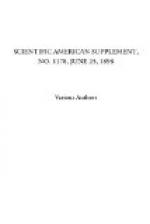man then lived in the rudest possible condition of
savagery. He has, little by little, through long
centuries and millenniums of painful struggle, survived
in made his weapons and his most effective tools for
the time being would be a good criterion to go by,
because these weapons and tools enabled him to conquer
not only the wild beasts around him and his fellow
man also, but nature as well. These materials
are three in number. They particularly apply
to European archaeology, but, in a general way, to
the archaeology of all continents. The one is
stone, which gave man material for the best cutting
edge which he could make for very many millenniums
of his existence. After that, for a comparatively
short period, he availed himself of bronze—of
the mixture of copper and tin called bronze—an
admixture giving a considerable degree of hardness
and therefore allowing polish and edge making.
The bronze age was not long anywhere. It was
succeeded by that metal which, beyond all others,
has been of signal utility to man—iron.
We live in the iron age, and it is from iron in some
of its forms and products that all our best weapons
and materials for implements,
etc., are derived.
We have, therefore, the ages of stone, of bronze and
of iron. These are the measures, from an artistic
source, of the advancement of human culture; and they
certainly bear a distinct relation to all man’s
other conditions at the time. A tribe which had
never progressed beyond the stone age—which
had no better material for its weapons and implements
than stone—could never proceed beyond a
very limited point of civilization. Bronze or
any metal which can be moulded, hammered and sharpened
of course gives a nation vast superiority over one
which uses stone only; and the value of iron and steel
for the same purposes I need not dwell upon.
To be sure, we have here several measures; and it
would seem more desirable, if we could, to obtain
one single measure—one single material
or object of which we could say that the tribe that
uses or does not use that to an equal degree is certainly
lower or, in the other respects, higher than another;
but I believe that there has been no single material
which has been suggested as of sufficient use and
value in this direction to serve as a criterion; but,
yes! I remember there was one and, on the whole,
not a bad one. It was suggested by Baron Liebig,
the celebrated chemist, who said: “If you
wish a single material by which to judge of the amount
of culture that any nation, or, for that matter, any
individual, possesses, compared to another one, find
out how much soap they use. Nothing,” he
said, “more than personal cleanliness and general
cleanliness differentiates the cultured man from the
savage;” and as for that purpose he probably
had in view a soap, he recognized that as the one
criterion. It is not amiss, but open, also, to
serious objections; because there are tribes who live
in such conditions that they can get neither water
nor soap; and the Arabs, distinctly clean, are not
by any means at the highest pinnacle of civilization.




